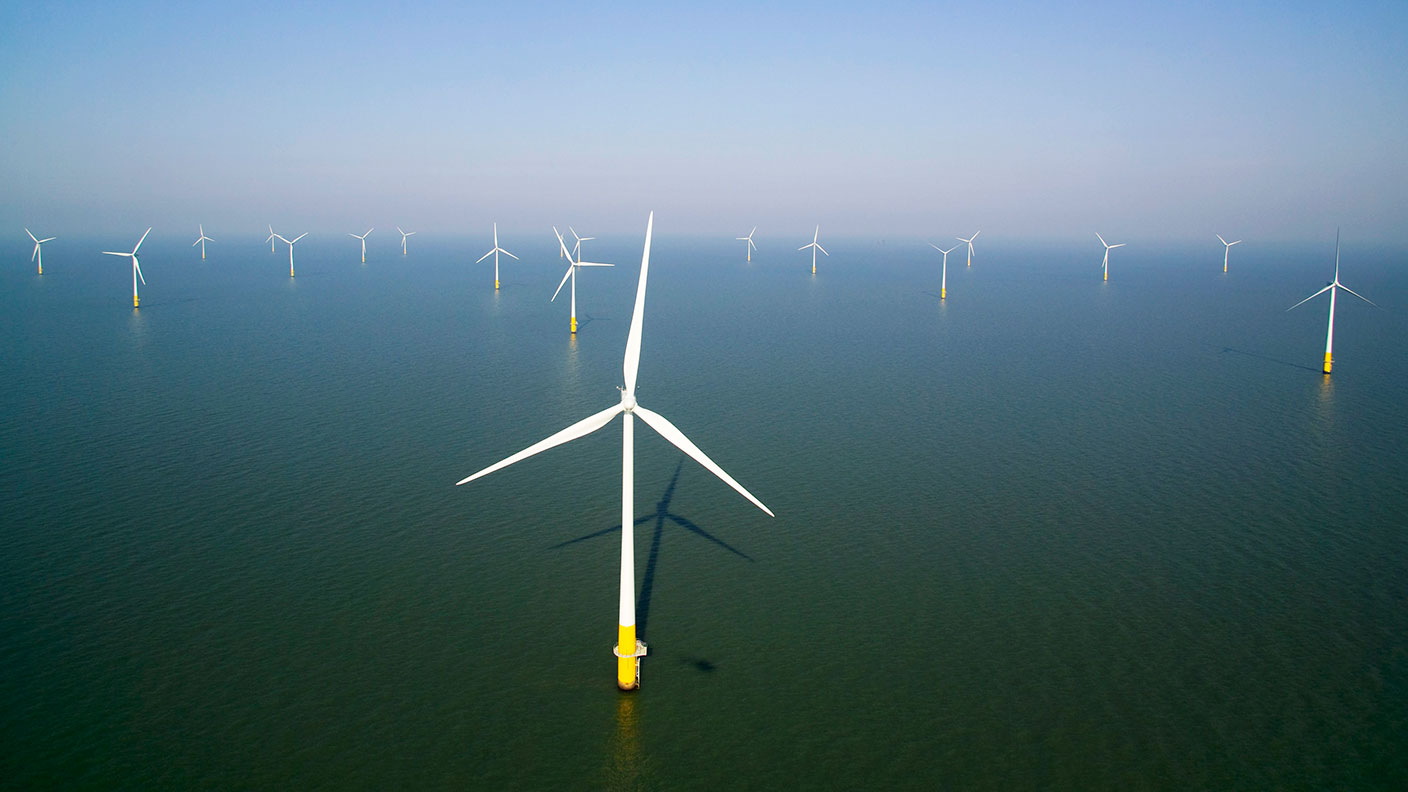Power your portfolio with renewable-energy stocks
The COP26 conference showed that fossil fuels are on their way out. This is a big opportunity for companies developing the equipment and technology that will make green energy viable, says Matthew Partridge


As the COP26 conference in Glasgow showed, world leaders are under huge pressure to slash carbon emissions by phasing out fossil fuels and embracing renewable energy. This transition is likely to lead to a massive increase in overall global demand for electricity as people opt for electric vehicles rather than cars fuelled by petrol and use electricity rather than gas or coal to heat their homes.
David Morrison, senior market analyst at trading platform Trade Nation, estimates that the world “will need around two to three times the electricity currently produced”. No wonder, then, that enormous sums are being invested in meeting this additional demand in a sustainable way. The expenditure is already starting to bear fruit.
Nick Scullion of Foresight Capital Management notes that the costs of operating and equipping renewable energy plants are falling. In many parts of the world renewables are entering what he calls a “Goldilocks moment” in which their costs are close, or even in some cases equivalent, to the cost of fossil fuels.
MoneyWeek
Subscribe to MoneyWeek today and get your first six magazine issues absolutely FREE

Sign up to Money Morning
Don't miss the latest investment and personal finances news, market analysis, plus money-saving tips with our free twice-daily newsletter
Don't miss the latest investment and personal finances news, market analysis, plus money-saving tips with our free twice-daily newsletter
Of course, many technical challenges remain, especially around grid connection and storage, but these are being addressed. This backdrop bodes well for firms at the cutting edge of renewables technology and for the sector’s equipment manufacturers.
A bright future for solar power
Solar power is the third-largest source of renewable energy in the world, behind wind and hydropower, according to BP’s Statistical Review of World Energy. It has enjoyed a “meteoric rise” over the past decade, says Nick Boyle of Lightsource BP, the largest solar developer in Europe.
Boyle notes that the “cost of buying a solar panel is now 1/12th the price it was 12 years ago, while the typical size of a panel has increased from 200 to 250 watts per panel to 500 watts”. Panels are also much more efficient, with the best “able to capture 20% of the energy from the sun, up from 13%” previously.
Overall, “the cost of pretty much every aspect of solar energy, from equipment to generation, has fallen”, says Boyle. So the technology “can now compete with coal in many markets, even when it doesn’t receive a subsidy”, making it the most economical form of renewable energy. This is partly due to the advent of large Asian firms using economies of scale to drive down prices. Small and medium-sized firms elsewhere had previously dominated the sector.
But technological advances that have given energy companies (and consumers) much more “bang for their buck” have been another key development. Boyle expects these improvements to continue with the emergence of bifacial panels, which can catch the reflected light from the ground.
Bifacial panels aren’t the only technology that could boost the appeal of solar power. Kevin Chin of Arowana thinks that there are three radical technologies currently in development. With the efficiency of the silicon inside solar cells close to reaching its limit, researchers at Berkeley College, University of California and the University of New South Wales are trialling the addition of perovskite to silicon. Perovskite materials contain a crystal structure that gives them a high solar efficiency, while they are more versatile than silicon. Early results have been so promising that the Hunt family of oil explorers has set up its own company, Hunt Perovskite Technologies, to develop pervoskite solar panels commercially.
Chin thinks floating solar farms could catch on too. While they are currently an “oddity”, they have “become much more economic to install” and have advantages in places “where land is at a premium”, such as Singapore. They are also more efficient than plants sited on land, “since the water has a cooling effect” that helps them absorb infrared rays better.
Perhaps the most interesting development is “anti-solar technology”: solar cells that produce power by emitting infrared rays during the night. During the day the panel, which is cooler than the sun’s rays, absorbs light and heat; at night it will be warmer than its environment, so it will radiate heat. While researchers admit that such panels would produce much less energy than normal ones, they would be a source of around-the-clock power.
Wind energy is picking up
Chin admits that wind power “isn’t developing quite as fast as solar”, as advances in technology, engineering and equipment in this area tend to be “incremental’ – especially compared with the breakneck pace of change in solar energy. However, wind remains the second-largest source of renewable energy. And while onshore wind farms are controversial owing to their impact on the landscape, “offshore wind is becoming more and more economic”.
Chris Holmes and Chris Tanner of JLEN Environmental Assets Group agree that “offshore wind farms will be a major part of the energy mix” in most developed countries, with further cost reductions coming from “the movement to ever-larger capacity platforms and the use of bigger machines”. They note that while older turbines tended to generate around 1.6 to two megawatts of power each, today’s can generate around five, while “some in Sweden can even generate up to eight”. Several manufacturers are working on developing software that can help predict the speed and direction of the wind, enabling the turbines to be adjusted to maximise output.
Turbines that are “bigger than skyscrapers” and software improvements that can allow turbines to operate in a wider range of conditions are all areas where the technology is improving. But bladeless turbines could also help wind power, says Scullion. Such turbines capture the vibration of the wind without the need for blades or a mechanical motor.
Not only do they look much more aesthetically pleasing, allowing them to be used in a wider range of areas, but the removal of the blades also eliminates the risk of birds being caught in the turbines, which is one of the reasons why wind farms are unpopular.
Harnessing water and waves
Hydropower is not only the largest source of renewable energy, “but also the oldest... we’ve been harnessing the power of rivers for a long time”, says Scullion. As well as generating energy by driving a turbine, hydropower comes with the added advantage that it can be used to store power. This technology, known as pumped storage, involves using electricity generated during periods of low demand to drive water up a hill, or between reservoirs at different elevations, only to release it later to flow down and produce electricity when more is needed.
Rivers and dams aren’t the only way to harness the power of flowing water, says Stuart Murphy, founder of tidal-energy project TPGen24. Tidal energy, essentially “a hydro plant in each direction to capture both rising and falling tides”, has the potential “to deliver energy 24 hours a day” – unlike wind and solar, which are dependent on the weather, time of day and season.
In a country such as the United Kingdom, with its relatively large coastline, this means that it could deliver much “constant, baseline energy”. The latest systems in development allow energy to be stored, so it could also respond to changes in demand.
Tidal energy has huge potential and could ultimately produce “up to half of the UK’s energy needs”, agrees Ashley Slade of engineering consultants Expleo Group. However, at present the technology is being hampered by several obstacles, such as the need for large, complicated surveys and long construction times of up to a decade. Operating in a marine environment is also challenging: just one strand of seaweed in the wrong place “can cut efficiency by up to 20%”. Still, several large companies are working on making the technology more economically viable, using composite materials and vertical turbines to boost durability and efficiency.
Agrifuel is a growing field
The final major source of renewable energy is biomass, which involves the conversion of agricultural products into energy; one common process is turning sugar or corn into ethanol, a fuel. While purists might argue that biomass is not a proper renewable-energy source, since carbon is released when the fuel is burned, JLEN’s Holmes and Tanner point out that the fact that carbon is taken out of the air when the crops are first grown means that the net impact on emissions should be zero. They note that the rise of carbon-capture technology, which takes the carbon and recycles it for use in food and beverages, means that biomass is now “carbon-negative”.
Another form of biomass energy is anaerobic digestion, whereby special bacteria are used to break down waste such as animal slurry, cow manure and discarded food. While the process “has been known about for decades”, they point out that recent improvements in technology have made the process more efficient, allowing more feedstock to be produced and gas to be released. Producers have become better at tweaking the range of feedstock to increase yield further. Biomass has great potential in heavy industry, says Chin. Mining giant Rio Tinto has pioneered a process that will enable biofuel to replace coal in the conversion of iron ore into steel, “which is where 70% of the emissions in steelmaking occur”. Rio is working with the University of Nottingham to develop it further.
Storing green energy
Cheap generation isn’t the only technological challenge for renewable energy. The power produced also needs to be integrated with the national grid so that the system is stable and consistent enough to produce enough energy to meet demand, says Chris Kimmett, director of the power grids business unit at Reactive Technologies.
Until recently, the short-term stability of the grid depended on inertia: turbines and industrial motors powered by oil, coal and gas were not only very good at producing constant amounts of energy, but also briefly kept turning even if the power plants driving them went offline.
However, since solar and wind power don’t provide the same degree of inertia, the amount of electricity that they produce varies from second to second. In essence, a grid powered by renewables “is like a motorbike, rather than a steam train”, says Kimmett.
In 2020 the National Grid tried to take advantage of greatly reduced overall demand to experiment with an all-renewable grid for a few minutes “only to decide that it wasn’t stable enough, forcing it to cut the proportion of renewables to 83%”. Solving this problem will require “artificial intelligence to predict fluctuations in supply” and “fast-acting batteries that can compensate for falls in output”.
Progress is being made on both fronts, say Dan Travers and Laurence Watson, heads of data science and technology at UK technology-accelerator Subak. Several companies are trying to use machine learning to enable renewable power companies and the grid to forecast more accurately fluctuations in production so that batteries can be charged in anticipation of any dips in output. Moreover, the price of lithium-ion batteries, increasingly used for short-term storage, is falling dramatically “thanks to the economies of scale generated by the rise in demand for electric cars”.
While lithium batteries are ideal for very short-term energy storage, other battery technologies have great potential for storing energy over longer periods. Travers and Watson are especially impressed by start-up Form Energy, which has developed an “aqueous air-battery system” that can store and dispatch energy for up to 100 hours at a much lower cost than a lithium-ion one. For longer, seasonal storage, batteries containing hydrogen look promising.
The progress in battery technology will help renewable energy to continue growing “exponentially” says Carlton Cummins, co-founder and chief technology officer at Aceleron Energy, a battery specialist. However, one problem created by the rapid changes in technology is that “many renewable firms are worried about investing in batteries, only for them to become obsolete”.
What’s more, many batteries produced by companies such as Tesla “can’t be upgraded to take advantage of innovations that come in after they are purchased”. So several firms, including Aceleron, are developing batteries that are much easier to upgrade.
What to buy now
Many renewable-energy technology companies are not publicly listed. Ordinary investors do, though, have access to the big oil explorers, who are investing large sums of money in renewables while selling off their legacy fossil-fuel businesses.
For example, Royal Dutch Shell (LSE: RDSB) recently spent a large sum of money on a majority stake in the Emerald floating wind project, which aims to generate 1.3 gigawatts from floating wind farms situated between 35 and 60 kilometres off the coast of Ireland.
Thanks in part to its pariah status with investors focused on environmental, social and governance (ESG) concerns, Shell trades at 6.8 times 2022 earnings, with a dividend yield of 4.5%, but it should be rerated as it embraces renewables.
Another oil company actively positioning itself for a future dominated by renewable energy is BP (LSE: BP). Thanks to its CEO, Bernard Looney, BP is starting to sell many of its fossil-fuel projects to fund investment in solar and wind projects. It owns half of Lightsource BP, which specialises in solar projects and technology. Again this strategy should help investors to buy a dependable income stream at a discount today – BP is on a 2022 price/earnings (p/e) ratio of 6.2 and a dividend yield of 5.3% – while benefiting from changing attitudes in the future as reduced stigma boosts valuations.
Nick Scullion of Foresight Capital Management likes Clearway Energy (Nasdaq: CWEN), which builds, operates and maintains solar and wind-energy plants, as well as battery-storage facilities, across the US. Scullion thinks that Clearway is set to be a prime beneficiary of President Joe Biden’s infrastructure bill.
He deems the bill to be an “absolute gamechanger” because it contains various tax incentives to boost renewable energy. Revenue is growing by around 5% a year, more than justifying the fact that the company trades at around 20 times 2022 earnings. The stock also offers a solid dividend yield of 3.7%.
A purer play on the development and engineering side of renewable energy is Denmark’s Vestas Wind Systems (Copenhagen: VWS). It specialises in designing, manufacturing, installing and servicing both offshore and onshore wind turbines.
Vestas has a 20% share of the installed onshore turbine market and 15% of the offshore one, more than any other firm, and services more than 50,000 turbines, accounting for over 100 gigawatts of combined capacity. It trades on a 2022 p/e of around 30, but this is more than justified by revenue growth of approximately 50% over the past four years.
A riskier bet is VivoPower International (Nasdaq: VVPR). VivoPower concentrates on technology and engineering relating to electric vehicles, batteries and solar energy. While VivoPower isn’t making any money yet, revenues are growing fast, jumping from $13.6m in 2019 to $40.4m in 2021, and analysts’ sales forecasts remain encouraging.
The company is working on various projects, ranging from solar farms in both the US and Australia to electrification and decarbonisation work in the mining industry. VivoPower also has enough cash on hand to get it through the next few years.
Get the latest financial news, insights and expert analysis from our award-winning MoneyWeek team, to help you understand what really matters when it comes to your finances.

-
 Metals and AI power emerging markets
Metals and AI power emerging marketsThis year’s big emerging market winners have tended to offer exposure to one of 2025’s two winning trends – AI-focused tech and the global metals rally
-
 8 of the best houses for sale with beautiful fireplaces
8 of the best houses for sale with beautiful fireplacesThe best houses for sale with beautiful fireplaces – from a 15th-century cottage in Kent to a 17th-century palazzo in Oxfordshire
-
 Metals and AI power emerging markets
Metals and AI power emerging marketsThis year’s big emerging market winners have tended to offer exposure to one of 2025’s two winning trends – AI-focused tech and the global metals rally
-
 8 of the best houses for sale with beautiful fireplaces
8 of the best houses for sale with beautiful fireplacesThe best houses for sale with beautiful fireplaces – from a 15th-century cottage in Kent to a 17th-century palazzo in Oxfordshire
-
 King Copper’s reign will continue – here's why
King Copper’s reign will continue – here's whyFor all the talk of copper shortage, the metal is actually in surplus globally this year and should be next year, too
-
 Luana Lopes Lara: The ballerina who made a billion from prediction markets
Luana Lopes Lara: The ballerina who made a billion from prediction marketsLuana Lopes Lara trained at the Bolshoi, but hung up her ballet shoes when she had the idea of setting up a business in the prediction markets. That paid off
-
 British blue chips offer investors reliable income and growth
British blue chips offer investors reliable income and growthOpinion Ben Russon, portfolio manager and co-head UK equities, ClearBridge Investments, highlights three British blue chips where he'd put his money
-
 Coreweave is on borrowed time
Coreweave is on borrowed timeAI infrastructure firm Coreweave is heading for trouble and is absurdly pricey, says Matthew Partridge
-
 Renewable energy funds are stuck between a ROC and a hard place
Renewable energy funds are stuck between a ROC and a hard placeRenewable energy funds were hit hard by the government’s subsidy changes, but they have only themselves to blame for their failure to build trust with investors
-
 Profit from document shredding with Restore
Profit from document shredding with RestoreRestore operates in a niche, but essential market. The business has exciting potential over the coming years, says Rupert Hargreaves